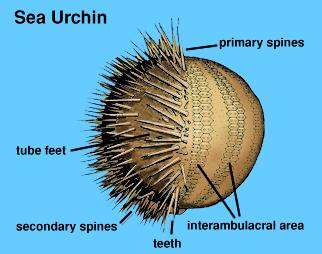|
|
Echinoderms - Sea Urchins
Class Echinodea: Sea Urchins
Sea Urchins are globe-shaped or mildly flattened animals. They have an outer, solid, skeletal structure called a test, which consists of hundreds of interlocking, spine-bearing, calcareous plates.
The test is divided into five segments. All wall plates carry moveable spines, hinged onto knob-shaped tubercles.
The primary spines may vary in shape, while secondary spines usually have little sculpture.

Sea Urchins are scavengers that feed on algae and animal remains.
Sea Urchins move on hydraulic tube feet in much the same way as Sea Stars.
![]() Common Sea Urchin, Heliocidaris
erythrogramma. Found at low tide levels, in pools and gutters around
southern Australia. If you are swimming and stand on one, its spines may
stick into your foot and break off, being very difficult to dig out.
Common Sea Urchin, Heliocidaris
erythrogramma. Found at low tide levels, in pools and gutters around
southern Australia. If you are swimming and stand on one, its spines may
stick into your foot and break off, being very difficult to dig out.
![]() Thickened
Sea Urchin, Holopneustes pycnotilus. A beautiful pink coloured,
globe-shaped sea urchin with a small distribution range along central
New South Wales.
Thickened
Sea Urchin, Holopneustes pycnotilus. A beautiful pink coloured,
globe-shaped sea urchin with a small distribution range along central
New South Wales.
| For more information on Echninoderms visit MESA Echinoderms |
References:
Bennett, I. (1987) W.J. Dakin's classic study: Australian Seashores. Angus & Robertson, Sydney.
Davey, K. (1998) A Photographic Guide to Seashore Life of Australia. New Holland, Sydney.
Edgar, G.J. (1997) Australian Marine Life: the plants and animals of temperate waters. Reed Books, Kew.
Quinn, G.P., Wescott, G.C. & Synnot, R.N. (1992) Life on the Rocky Shores of South-Eastern Australia: an illustrated field guide. Victorian National Parks Association, Melbourne.
Marine Research Group of Victoria (1984) Coastal Invertebrates of Victoria: an atlas of selected species. Museum of Victoria, Melbourne.
Common
Sea Urchin
Thickened Sea Urchin
Home
Page
Taxonomy
Biogeography
Rocky Shores
Tidal Levels
Intertidal Zonation
Environmental Factors
Biological
Factors
Feeding Relationships
Activities
Glossary
References
 Life
on Australian Seashores
Life
on Australian Seashores
by Keith Davey (C) 2000
Learning Consultant
- Media
The University of Newcastle
email at australian_seashores@hotmail.com
Scientific Consultant: Phil
Colman
site created 01.01.98 : updated 01.04.2000
